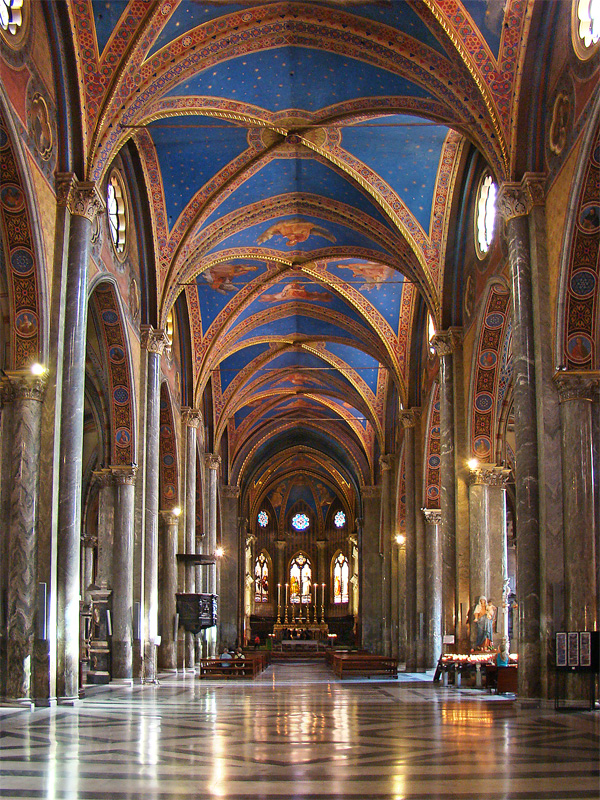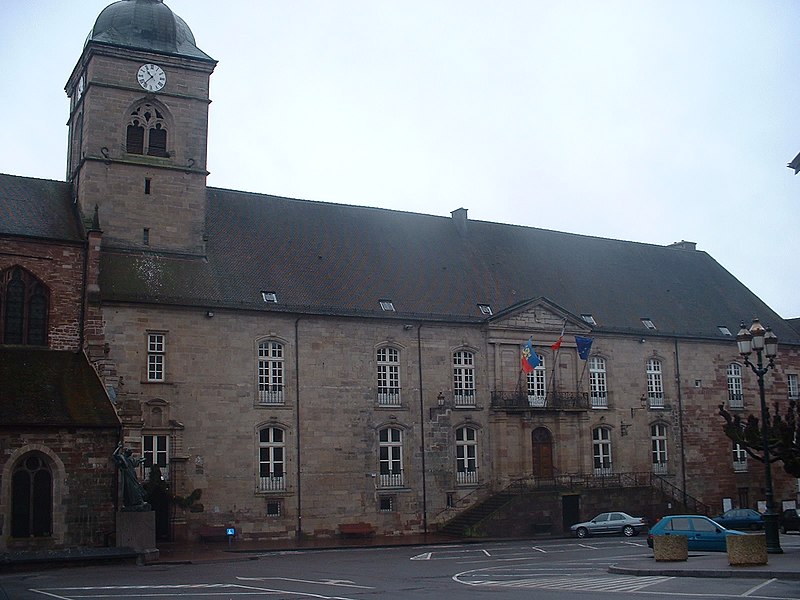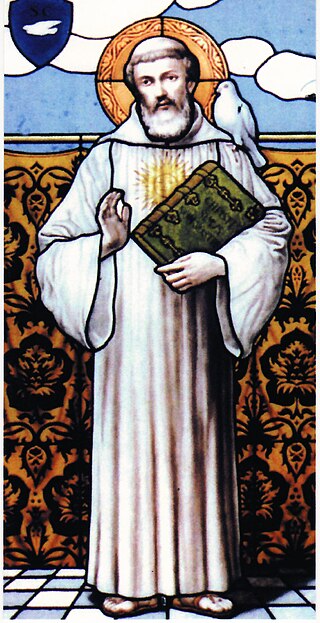Statue of St Columbanus in Luxeuil, France
Yesterday morning, 12 October, Cardinal Seán Brady, retired archbishop of Armagh, Ireland, was the Principal Celebrant at Mass at the Church of Santa Maria sopra Minerva, Rome, at the opening of the Jubilee Year to mark the 1400th anniversary of the death of Saint Columbanus. The Irish missionary saint, also known as 'Columban', died in Bobbio in northern Italy, on 23 November 1615. He is the patron saint of the Missionary Society of St Columban, formally established in 1918, to which I belong.
Cardinal Seán Brady [Wikipedia]
Pope Francis greeted the pilgrim group marking the centenary at the end of his address today after praying the Angelus.
Interior of Santa Maria sopra Minerva, Rome [Wikipedia]
Here is the homily of Cardinal Brady, published in Zenit.
I am very pleased to see you all here in Rome, in this beautiful Church of Santa Maria Sopra Minerva. We are here to celebrate the opening of the Jubilee Year of Saint Columbanus. The Jubilee Year commemorates the 1400th anniversary of the death of that great monk and missionary, who died in Bobbio in AD615.
The Jubilee Year was opened yesterday in the Basilica of Saint John Lateran, after the arrival and solemn reception of the relics of the saint from Bobbio, followed by a Mass, celebrated by Cardinal Vallini, Vicar General of Pope Francis for the Diocese of Rome.
Monastery ruins at Annegray, France [Wikipedia]
In a sense, the ceremony brought closure finally to the earthly pilgrimage of Columbanus who ardently desired to reach Rome, but failed to do so since he died at Bobbio – a diocese and a city which not only preserves his mortal remains, but admirably keeps alive his memory, example and spirit to this day.
In fact, we Irish are profoundly touched by the fact that so many parishes in Italy and elsewhere, so reverently keep alive the memory of Columbanus – an outstanding monk and missionary and saint.
Basilica of San Colombano, Bobbio, Italy [Wikipedia]
I remember the first time I visited Bobbio – some 50 years ago and the warm welcome we received - simply because we were Irish. I remember the bunch of fresh flowers placed on his tomb – clear proof that someone, with a grateful heart, after all the centuries, had remembered the poor abbot – come from a distance to announce the Good News.
But what has Columbanus to say to us – citizens of the third millennium – after fourteen centuries? Sure, Columbanus is far distant from us in time and space, but the relevance of his thought and spirituality is extraordinary. This was underlined by Saint John Paul II in a message to the people of Luxeuil in 1990 to commemorate the foundation of the monastery there by Columbanus fourteen hundred years earlier when the Holy Father wrote:
You are recalling a past that is still alive and recognising the gift, given by God, to the Church, in the person of great pioneers like Saint Columbanus. For the Lord has marvellously combined in Saint Columbanus, love of evangelisation, devotion to monastic life and the fullness of human dignity.
Abbatial Palace, Luxeuil, France [Wikipedia]
In this Mass of Thanksgiving, we too express our gratitude to God for the gift of the faith and for the goodness of all those who played any part in handing onto to us the Good News.
To help us to do so better, we recall the example of Columbanus. During the long years of being a monk in the monastery of Bangor and earlier in Cleenish – it obviously became clear to him that, in every age, the Church is called to make all its members disciples and missionaries of Christ – Christ who is the way – the truth and the life. So he sought the permission of his Abbot – the renowned Comgal - to leave the Monastery of Bangor and to set out as a pilgrim for Christ. Abbot Comgall eventually agreed and so it was that Columbanus set out, on his missionary journey, accompanied by twelve brothers from the community. So there began the long journey which would take them first to present-day France, then Germany, Switzerland, Austria and finally to Bobbio in Italy. It was the summer of 592 – Columbanus would have been fifty years of age and rather old for such an adventure in conditions of those days.
St Columbanus, stained glass window, Bobbio Abbey crypt [Wikipedia]
Over the next twenty years he founded a number of monasteries: Annagray and Luxeuil, in France; Bregenz in Austria and Bobbio here in Italy.
Saint John Paul II often called for a new evangelisation of Europe after the decline in faith of recent decades. Saint Columbanus could be seen as a model and a patron of this new evangelisation. His missionary work could also be described as a second, and new, announcing of the Good News after the damage inflicted by the invasions from abroad and by the fall of the Roman Empire in the West. Columbanus and his monks brought the light of faith to people who, themselves, in turn became evangelisers until Europe became, once more, a Christian continent.
Everywhere he went, Columbanus remained devoted to the monastic way of life. He founded monasteries; he wrote his own Monastic Rule. It can be truly said that the ways opened up through Europe, and the monasteries founded by him, were often the places where, later on, the Benedictine rule would flourish. With Saint Benedict, he helped to lay the basis for the European Monasticism of the Middle Ages.
The rule of Columbanus recommended that the monks should confess privately, and often, to one particular confessor. It was an effort to address the crisis that flowed from having only public confessions which were rarely celebrated more than once in a lifetime. Perhaps he has something to say to all of us today on that topic.
Columbanus loved the monastic life of prayer and contemplation; the silence and the solitude; the fasts and the penance. He would have seen them not alone as the golden way to a closer union with God but also as the indispensable pre-requisite of successful conversion and the winning of hearts and minds to the following of Christ.
It is the same spirituality that saw Saint Thérèse become the Patroness of the Missions because of her prayers and sacrifices on behalf of the missions. There can be no renewal of faith that is not preceded by a renewal of prayer because to evangelise is to transmit life and is the fruit of holiness.
Bregenz, Austria [Wikipedia]
In Saint Peter’s Basilica there is a mosaic dedicated to Saint Columbanus. It bears the inscription – If you take away freedom you take away dignity. The phrase is taken from one of the letters of Columbanus. Indeed it is something that could have been written, not only by a seventh century missionary, but also by a citizen of today’s world, where so many people live in terrible conditions of slavery, fear and oppression. In addition to the ancient forms of oppression such as war, poverty, loneliness, violence and exile, the modern world has new forms of slavery such as drug and alcohol addition, which are particularly destructive of human dignity.
The glory of God is the human person – fully alive. Columbanus succeeded in uniting faith with human dignity and freedom. These are the values on which, for centuries, the identity of Europe was founded and without which the Europe of today risks failing to have a future. May the jubilee year of Saint Columbanus, as well as his life and his writings, inspire all of us to strive for the defence of basic human rights for all.
We make our own the prayer of Saint John Paul II who, writing to the people of Luxeuil, expressed the hope that all who would commemorate the great founder of their famous abbey would be spurred to even greater fidelity to Christ and enthusiasm for His Kingdom.
My hope and prayer is: that by participating in this pilgrimage and Jubilee celebrations, and through the intercession of Saint Columbanus, we may all draw closer to Christ – the way, the truth and the life.
AMEN
Statue of St Columban, St Columban's, Bristol, RI, USA









No comments:
Post a Comment